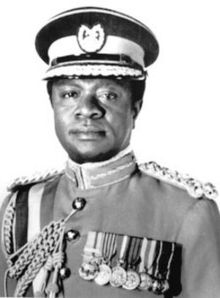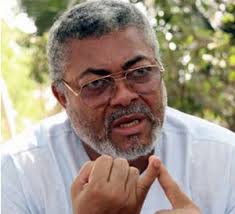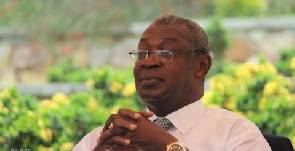 Ghana’s second attempt at democratic administration suffered a set-back when Colonel Ignatius Kutu Acheampong, then Commander of the Fifth Battalion staged a successful coup d’ etat to oust Busia’s government on 13 January, 1972. A military junta – the National Redemption Council, NRC was formed with Lt. Colonel Acheampong as Head of State and Chairman. Members of the Council were: Major A.H. Selormey, Major Kwame Baah, E. N. Moore as Attorney General, Major K. B. Agbo, Brigadier N.Y.R Ashley – Larsen, Commodore P.F. Quaye -Navy Commander, Brigadier C. Beausoliel Air Force Commander, Major R. J. A. Felli, Colonel E.A. Erskine – Army Commander, Lt. Col. C. D. Benni, Colonel J.C. Adjeitey and J.H. Cobbina, IGP.
Ghana’s second attempt at democratic administration suffered a set-back when Colonel Ignatius Kutu Acheampong, then Commander of the Fifth Battalion staged a successful coup d’ etat to oust Busia’s government on 13 January, 1972. A military junta – the National Redemption Council, NRC was formed with Lt. Colonel Acheampong as Head of State and Chairman. Members of the Council were: Major A.H. Selormey, Major Kwame Baah, E. N. Moore as Attorney General, Major K. B. Agbo, Brigadier N.Y.R Ashley – Larsen, Commodore P.F. Quaye -Navy Commander, Brigadier C. Beausoliel Air Force Commander, Major R. J. A. Felli, Colonel E.A. Erskine – Army Commander, Lt. Col. C. D. Benni, Colonel J.C. Adjeitey and J.H. Cobbina, IGP.
The justification General I. K. Acheampong presented by the newly constituted NRC focused on three main issues: first, the deteriorating state of the economy, and particularly, the negative repercussions of the devaluation of the cedi; the alleged corruption of the Busia regime and third, their (ousted government’s) inability to show any understanding for the conditions of the common man. At his first press conference, Colonel Acheampong did not only deplore the previous government’s lack of will to act decisively on this (economic) crisis, but further attacked the system that exploited the ordinary people, the workers and the farmers on whose sweat and toil the wheel of the economy turns.
Achievements:
The 1971 budget was revised in accordance with the priorities which the NRC wanted to follow for the rest of the 1971/72 fiscal year. The revision laid strong emphasis on agriculture and the provision of social amenities for the people. In this direction, as a first phase of an agricultural revolution, the government launched the “Operation Feed Yourself” – OFY programme. The programme caught on quite well with Ghanaians as backyard gardening began to attract the attention of even the urban dweller and all categories of people: housewives, professionals such as teachers, doctors, lawyers and high level public servants were all seen tilling the land and growing basic foods items such as vegetables.
Liberal government loans were given to encourage farming. Agriculture, including livestock, registered a growth rate of 4.5 percent in 1972, 6 percent in 1973 and 7 percent in 1974. A fair assessment of the programme revealed remarkable success as in the 1974-75 seasons alone, 401,528 bags of rice were purchased from farmers by government rice mills. In fact, by 1975, there was hardly any food importation into the country. To accelerate development in the regions, a Regional Development Corporation was set up in each region in 1973 with an initial allocation of £800,000 for the ensuing three years to promote agriculture, industry and commercial businesses in the regions.
In 1975 the government launched the phase two of its programme “Operation Feed Your Industries” – OFYI, as a follow-up to the OFY. The emphasis was to produce selected industrial and cash crops such as rubber, sugarcane, cotton, groundnut, cashew etc. for export. Cotton was given particular attention as the producer price was raised from 20 to 70 pesewas per kilogram. The Cotton Development Board on its part received £4 million for expansion. To further boost production, the government undertook to supply farmers with improved seeds and seedlings, fertilizers and insecticide.
Expert agricultural advise was given free of charge. The Agricultural Development Bank was injected with more money to enable it give loans to industrious and needy farmers. In a bid to sustain the agricultural policy against the vagaries of the weather, various irrigation projects were launched by the NRC. On the 27 March, 1975, sod cutting was done to start work on a £5.7 million Tono Irrigation Project in the Upper Region. The Dawhenya Irrigation Project, the Okyereko Irrigation Project and the Nkrontrodu (near Elmina), were also started. The projects in the Central Region were to help the region cultivate over 1,500 acres of rice when fully operational.
To cushion the hardships facing the masses as a result of the devaluation of the cedi by Busia, the cedi was revalued by 42.0 per cent (i.e. NC1.00 to 78 US cents). Surcharges on imports were removed, and farmers were rewarded with an increase in the producer price of cocoa from NC8.00 to NC10.00 per ton. Workers also had the benefit of the repeal of the Industrial Relations (Amendment) Act, 1971 (Act 383); an increment in the minimum wage from NC0.75 to NC 1.00 and the abolition of the National Development Levy.
All future redundancy exercises that had been planned by private enterprises were stopped. To further alleviate the hardships of the working class and the populace in general, £65.5 million was voted for the importation of foreign food items in 1972 and an additional £30 million by May 1973. Car maintenance allowance and other perquisites for top civil service personnel which had been either reduced or abolished by the PP government were fully restored. University students were also satisfied when by a 1973 Decree – (The Student Loans Scheme Decree NRCD 142) was abolished.
Projects of no immediate economic value were suspended thereby saving for the country, an amount of £14.9 million. Only feeder roads that would ease foodstuff conveyance and help combat smuggling were to be constructed. An amount of £65.4 million was saved on the capital budget through the banning of the importation of luxury cars. The NRC also announced on February 5, 1972, the repudiation of about $94.4 million of loans incurred since February 24, 1966 as such contracts were “vitiated by and tainted with corruption, fraud or other illegality”. Some of the loans had repayment arrangement unilaterally rescheduled.
The government also reviewed Suppliers’ Credits entered into before February 1966 and accepted to enter into arbitration in respect of the debt repudiation at the International Centre for Settlement of Investment Disputes, Washington D.C., USA. It however, accepted to pay debts contracted on import credits, 180-day credits, liabilities of service payments and long-term debts arising from long-term loans and credits granted by the World Bank, International Development Association, the US government and other donor nations. By re-negotiating the country’s foreign debt, some sort of respite was gained with respect to debt servicing and other financial commitments of the country.
The government also established the outlines of a plan to expropriate foreign holdings and prepared to indigenise most enterprises. By decrees such as the Timber Operations (Government Participation) Decree, 1972 (NRDC 139), and the Mining Operations (Government Participation) Decree, 1972 (NRCD 132), the government acquired majority shares (55.0 percent) in all the foreign mining and timber companies. The Ashanti Goldfields Corporation -AGC, Consolidated African Selection Trust – CAST, and the Ghana Bauxite Company were affected by this state participation exercise while the African Manganese Company, the subsidiary of Union Carbide (USA) at Nsuta, was entirely taken over by the government under the new name of National Manganese Corporation. Under the timber decree, government acquired majority shares in such companies as Glicksten (WA) Ltd., and African timber and Plywood Company.
Participation was also opened in all major foreign owned commercial, banking and industrial establishments not only to government but to local capitalists as well. Thus for example, at least 40.0 per cent equity shares in such major multinational commercial and banking institutions as Mobil, Texaco, BP, UAC, UTC, Barclays Bank and Standard Bank were acquired by the state.
In others, Ghanaian shares were fixed at 55.0 per cent to 40.0 percent for the state and 15.0 per cent for Ghanaian capitalists. In another category of foreign owned enterprises which had employed capital of C500,000.00 or an annual turn-over of C1,000,000.00, Ghanaians were entitled to 50.0 per cent of equity shares. Among these were Ghana Rubber Products, Ghana Plastic Industry Ltd., Fabric Knitting and Dyeing Industries Ltd., and M. Captan. By Section 13(5) of the Ghanaian Enterprises Development Decree, 1975 (NRDC 330), workers were given the legal basis to participate in enterprises which were to “go public” under NRCD 329. Acheampong also embarked upon the provision of houses for the people. Under the “Low-Cost Housing Scheme”, the State Construction Corporation had by 1973 completed a number of housing projects. At the end of the phase one of this project, a number of houses were completed. These included, 60 at Dansoman (Accra), 50 at Cape Coast, 30 each in Kumasi, Sunyani, Tamale, Ho, Koforidua and Bolgatanga and 15 at Ketan (Sekondi).
Other areas to benefit were Asutsuare, Madina (Accra), Chirapatre (Kumasi), Winneba, Agona Swedru, Obuasi and Bawku. In all, about 2,300 houses were expected to be completed by the end of the period under review at the cost of $3 million.
The government of General Acheampong did well to re-generate a sense of patriotism and enthusiasm among university students in particular and students at various levels of education in general. For instance, students from the country’s universities and Komenda Teacher Training College showed their support by spending several hours harvesting sugarcane to feed the Komenda Sugar Factory. Similar activities by students were carried out in all parts of the country as their contribution towards the government’s efforts at revamping the economy. The working class was not left out as workers accepted the challenge of being punctual at their work places and discharging their duties with diligence.
On the supply of electricity to a wider section of the populace, a number of projects were completed under General Acheampong. Under the first phase of the rural electrification scheme, power stations and supply networks for Berekum, Wenchi, Sefwi Wiaso, Wa, Suhum, Offinso and Ashanti Bekwai were completed. Moreover, the Cape Coast-Asebu-Saltpond overhead line which had been operating at 11 KV was energized at 33 KV.
Six 3310.4 KV on-line substations were commissioned to serve Asebu township, Rose Lime Factory, Biriwa, Anomabo and Wankan Salt Industry. Also completed were a 33/11 KV substation at Saltpond, and the street lighting installations at Sovie Dzigbe, and Nsuta Buem. Several extension works and new equipment were provided to energize electricity supply to the Inchaban Water works (Takoradi), Japan Motors (Accra), Ghana Coldstores, L’air Liquide and Log and Lumbers Ltd., (Kumasi). High Voltage supplies were provided to Tata Brewery, the Bank of Ghana, UTC Motors workshop and the last, but not least, Ghana Commercial Bank (Liberty Avenue).
General Acheampong also commissioned the Togo-Dahomey transmission line which made it possible for the two countries to enjoy electricity supply from the Akosombo hydro-electric dam. Realizing the inadequate number of medical personnel in the country, the NRC established a second medical school – School of Medical Sciences (SMS) at the University of Science and Technology – UST, Kumasi, to train more doctors to help sustain health delivery in the country.
An Urban Health Centre was constructed at Mamprobi and renovation works was carried out at the Okomfo Anokye Teaching Hospital and the Mampong District Hospital. In the field of education, facilities were improved for elementary schools. This led to an increase in enrolment in 1972-73 by more than 38,500 over that of 1971-72. The 1974 Education Act provided that by 1976 eighty additional primary schools would be built and 4,000 more teachers in training were to be recruited. The Continuation School programme started by the Busia government was vigorously pursued and by the end of 1972-73 the number had increased to 328, an increase of more than 140 over the number in 1971/72.
Programmes offered were expanded to include salt-making, fitting, blacksmithing, electrical welding and vulcanizing. On secondary education, the 1972-73 enrollment was 60,774 as against 56,801 in 1971-72. The curriculum was also diversified to include commercial and practical subjects. Emphasis was laid on Shorthand, Typing, Carpentry, Tailoring and Technical Drawing. Some second cycle schools were also provided with new structures. They included a 3-storey dormitory block for the Presbyterian Boys’ Secondary School, Legon, and Ghanata Secondary School, Dodowa. Other schools which also benefited from the provision of new infrastructure were St. Louis Secondary School, Archbishop Porter Girls’ Secondary School and Pramso Secondary School. By NRCD 247, the NRC in December 1973 established the Ghana Teaching Service. In 1974, the decree was amended by the proclamation of NRCD 357 and the name was changed to Ghana Education Service.
The government also re-established at the Advanced Teacher Training College, Winneba, with courses in Science and Mathematics for failed degree candidates in Science and holders of the GCE ’A’ Level in Science of Mathematics who did not qualify for admission to the universities. Upon completion, the diplomats were to join the staff of secondary schools to strengthen the science departments.
The NRC inaugurated the Technical and Commercial Examinations Committee under the aegis of the West African Examinations Council to work out a programme for the establishment of a technical and commercial examination system to replace the overseas examinations of the City and Guilds of London, and the Royal Society of Arts with local ones based on syllabuses that will fully reflect the development needs of the country. As a further move to improve the quality of education, a 14-member National Advisory Committee on Curriculum for Pre-University Education under the Chairmanship of the Rt. Rev. Dr. Akwasi Sarpong, Catholic Bishop of Kumasi, was inaugurated by July 1973. The Committee was to advise the Commissioner and the Ministry of Education on the content of education at all levels of pre-university education that would reflect national needs and aspiration.
In its determined efforts to encourage the production of textbooks locally, an Authorship Development Fund of £50,000 was established. Under the control of the Ministry of Finance, the Fund was to provide financial assistance to Ghanaian and other local authors to write and publish more original works based on local conditions and experiences as teaching material to replace die extraneous materials which the country had had to import with its limited hard currency.
The NRC promulgated the NRCD 208 to establish the National Service Secretariat which put in place the National Service Scheme. It was to assign for a period of one year, a core of trained young Ghanaian graduates from the Universities, the Diploma Colleges and later Sixth Form to any needy area of national development. A number of roads were also constructed. They included the Nima/Maamobi highway, the Tamale-Morno road, Soronuasi-Morno trunk road, and the Bolgatanga-Bawku-Kulungugu trunk road. It was under Acheampong’s regime that the country’s motor traffic adopted the ’right hand drive’ way of driving. Ghana also joined the international community in converting its system of measuring to the metric one.




